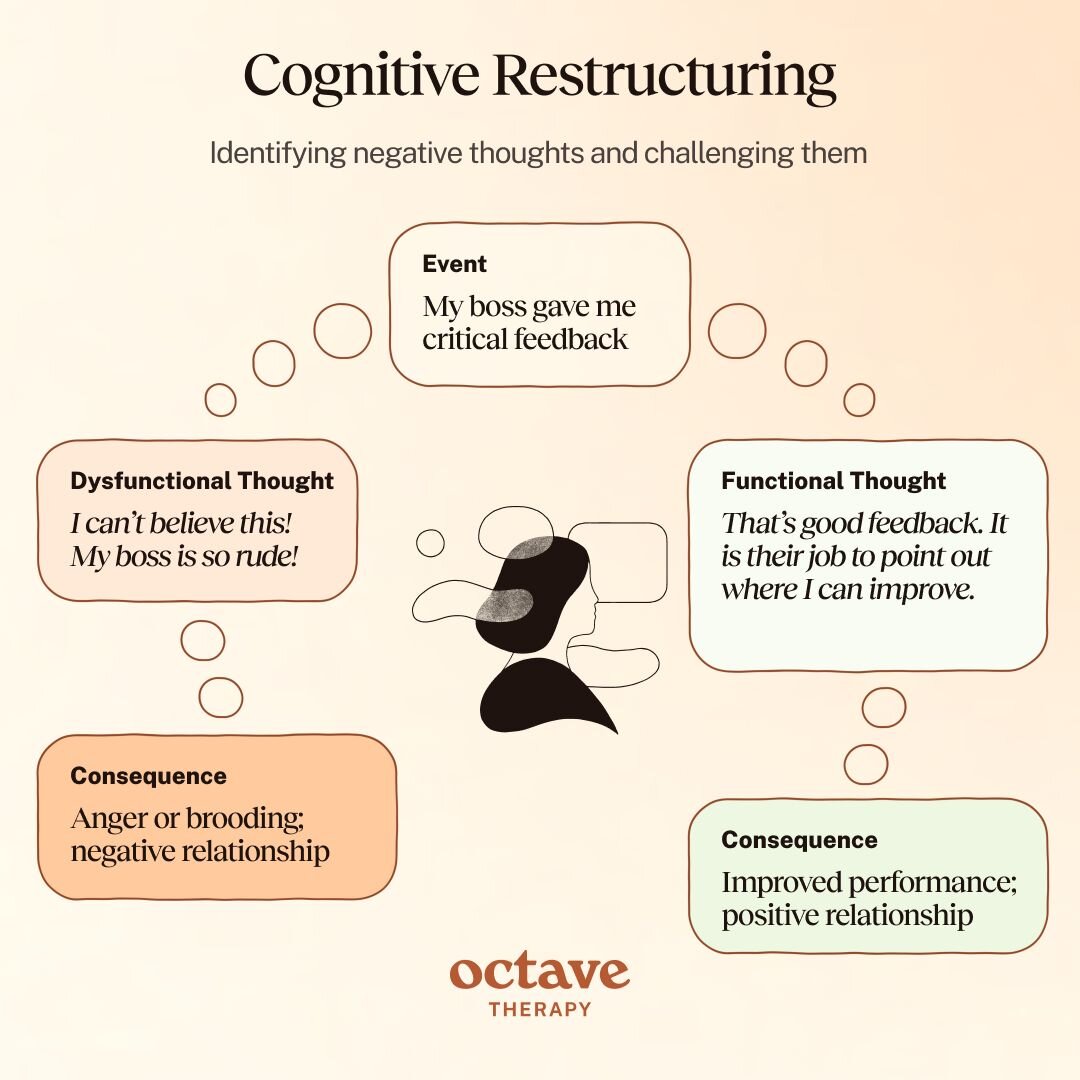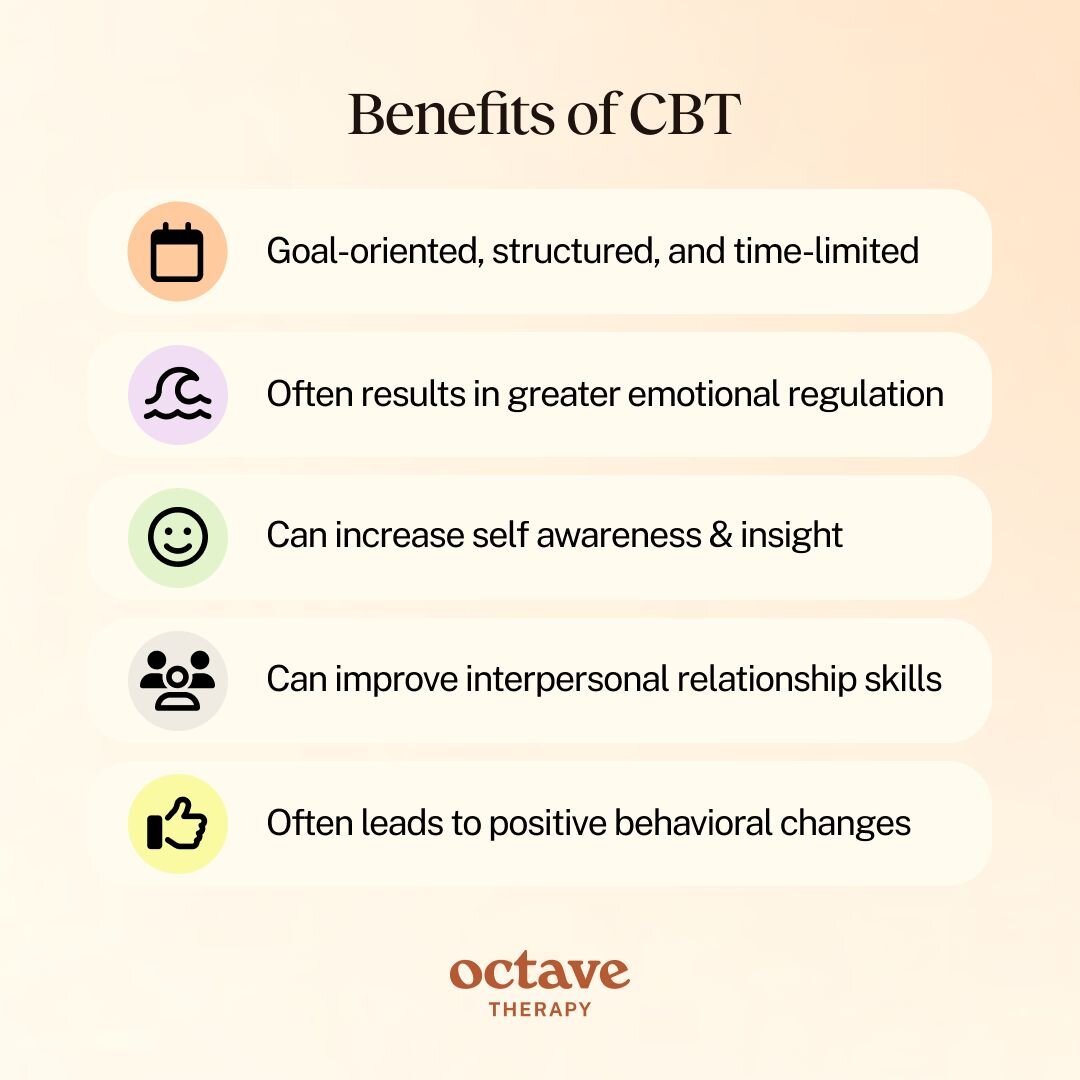
What is Cognitive Behavioral Therapy?
Overview
Going to therapy for the first time can feel like an intimidating prospect. Even if you’ve heard friends speaking about their experiences, seen fictional sessions in movies and TV shows, and read articles about it, you may struggle to envision what it’s actually like. The fact is that there’s no one-size-fits-all way to describe therapy.
However, therapists draw from a number of techniques and approaches to provide the most effective course for each client. An understanding of various approaches can help demystify therapy for those who are feeling hesitant and uncertain.
One of the most common approaches you will come across is cognitive-behavioral therapy (CBT). There is a good chance that the therapist you choose will use CBT as their primary approach or draw from its principles and techniques.
Cognitive-behavioral therapy (CBT) is a structured, time-limited, and goal-oriented psychotherapy. It has been proven effective in many studies since its development in the 1960s and, having been both expanded and refined in the decades since, its popularity has continued to skyrocket.
The primary goals of CBT are to improve emotional regulation, cultivate effective ways of thinking, and promote healthy behaviors. It does so by helping you identify and change thought patterns and behaviors that are contributing to day-to-day challenges and mental health issues. CBT is highly practical, providing a ‘toolbox’ of skills that you can use on a daily basis to improve your mental health and face difficulties head on.
How Does Cognitive-Behavioral Therapy (CBT) Work?
In order to begin to envision the CBT therapy process, it helps to understand how it works.
Cognitive-behavioral therapy began as a fusion of two different psychological approaches: cognitive therapy and behavioral therapy. Dr. Aaron T. Beck, who developed CBT, realized that both cognition (thoughts) and behaviors impact a person’s wellbeing. This is due to what is sometimes called the ‘cognitive triangle’.
The cognitive triangle refers to the interplay between thoughts, behaviors, and emotions. Each of these domains impacts the others and, in the process, influences a person’s overall wellbeing. This is something most of us already understand, if not necessarily on a conscious level. For example, if you start thinking of distressing problems that may occur, the feeling of anxiety arises, causing the urge to use whatever behaviors are most instinctive to you, e.g. preventative action, avoidance, etc.
This can work in any direction. Feelings of anxiety might lead to specific thoughts and actions, while habitual behaviors can trigger thoughts and feelings.
CBT recognizes that this interconnectivity can be used to improve mental health – if you alter one component, the others are adjusted as well. In CBT, the therapist first identifies unhelpful patterns of thoughts, behaviors, and feelings, then provides skills with which to change them.

When you see a therapist who uses CBT, the process will typically follow this structure:
First Session: Getting to know each other
No matter the approach a therapist uses, the relationship between you and the therapist is fundamental to the process. In the first session, you begin to share your history and the concerns which have brought you to therapy. Your therapist will help you go deeper into some of the issues which come up to get a clearer picture of what you need from therapy.
While the therapist will not share many personal details of their own life, it’s important to take this opportunity to get a feel for them. You begin to sense how well you connect with them and how you experience their presence. Since building rapport is fundamental for the foundation of the therapeutic relationship, it is important to be open and honest, asking questions about the therapist’s style and approach and any concerns you may have.
Having begun to build the foundations, your therapist will work with you to identify your main areas of focus and goals for therapy, and to outline a plan of action. While this outline will guide how the following sessions proceed, your therapist will regularly assess whether the approach needs to be adjusted.
CBT provides a toolbox of skills and techniques which you learn and practice during therapy and reinforce at home.
CBT Skills and Techniques
All therapy approaches are sensitive to the person’s feelings and needs, but this doesn’t mean they’re not practical. CBT is a particularly practical approach, designed to be effective and efficient at achieving the person’s goals.
In CBT, your therapist will introduce you to a range of skills and techniques to adjust the way you think and behave. The most common of these include:
Cognitive Restructuring
Every person’s inner monologue includes thought patterns that have become habitual. These begin to develop in childhood and often become so ingrained that we don’t even notice they are there. In CBT, this is called ‘self-talk’.
Negative self-talk significantly impacts one’s mental health and wellbeing. If you frequently tell yourself that you will probably fail at a task, for example, you may experience anxiety and avoid even trying.
Cognitive restructuring is the crucial CBT practice of identifying negative thoughts and challenging them.
Challenging negative thoughts is not the same as suppressing them or saying no to them. On the contrary, it involves learning to notice when they arise, bringing them to the level of awareness, recognizing where they come from and what triggers them, and actively assessing whether or not they are rational.
The therapist plays an important role in practicing this skill on early occasions, as they provide an objective perspective, even when strong feelings make it difficult to separate fact from fiction.

Behavioral Activation
Another prominent skill in the CBT toolbox is behavioral activation. As we’ve explained, thoughts, feelings, and behaviors all affect one another. Certain behaviors, especially when repeated on frequent occasions, reinforce negative thoughts and feelings.
For example, someone who frequently engages in people-pleasing behaviors reinforces the thought that they’re not good enough as they are, along with feelings of guilt and shame. In contrast to cognitive restructuring, which would focus on challenging the thoughts, behavioral activation involves changing how one acts. In a scenario where they would usually dismiss their own needs and rush to do what someone else wants, they learn to start saying no.
The therapist helps the person practice the healthy behaviors in preparation for implementing them in real life. As new habits begin to form, the associated thoughts and feelings change too.
Additional CBT Skills and Techniques
Cognitive restructuring and behavioral activation are two of the most fundamental CBT skills. Both include a variety of techniques to achieve them. However, there are additional skills and techniques that are used in conjunction with them. They include:
- Exposure Therapy: A type of behavioral activation involving gradually facing one’s fears in a safe environment. It is often used in treatment of PTSD and phobias.
- Problem Solving: Improving one’s ability to break down issues and find solutions.
- Mindfulness and Meditation: Techniques to manage anxiety and stress.
- Activity Scheduling: Engaging in pleasant activities that may help improve mood.
Benefits and Drawbacks of CBT
Therapy is not a one-size-fits-all process and the range of approaches used reflects this. CBT is popular and effective, but there are other therapy modalities that work. The decision to do CBT should be one that the individual is involved in as their unique context and even personal preference matters.
As with all types of therapy, there are benefits and drawbacks of CBT. Let’s delve into the reasons why you might choose CBT, then discuss some of the reasons someone might not see it as a fit.
Benefits
The goals of CBT are similar to those of other therapies and it has been proven effective at achieving them. Courses of CBT improve emotional regulation, engender positive self-talk, help build self-esteem, encourage effective behaviors, and strengthen interpersonal relationships.
However, CBT has unique benefits in the specificities of the process and the range of issues it can treat.
Systemic Benefits
On a foundational, systemic level, CBT offers the following benefits:
It’s Goal-Oriented
There are some standard goals everyone wants to achieve in therapy: general wellness; better daily functioning; etc. In CBT, however, you set far more specific and measurable goals regarding regulating feelings that are causing you pain, stopping certain behaviors and opening up to others, and changing ways of thinking that don’t benefit you.
It’s Structured
A loose sense of structure is a feature of many types of therapies. Underlying this is the decision to let the process lead to revelations and transformation, rather than setting its course from the start. This can be a powerful and affirming approach for some people.
Others, however, benefit from structure, and this is an area in which CBT excels. When you set goals with your therapist at the beginning of CBT, you also outline a plan of action, which can be adapted if necessary, to achieve them.
Structure benefits not only those who find order and safety in it. It is also an important skill to learn for people who struggle with it. Learning to implement structure and routine can lead to greater stability, creating the foundation for sustained mental wellbeing.
This is not to say that CBT has to be rigid or cannot incorporate the flexibility of other modalities. Rather, since the structure is designed to meet the client’s goals or targets, it can be adapted when necessary and can include room for additional exploration as well.
It’s Time-Limited
Some modes of therapy continue indefinitely, lasting many months or years. This approach is ideal for some people. It gives the relationship with the therapist time to develop and evolve and can lead to meaningful growth and change.
However, many people are not interested in a therapy process without a proposed endpoint, especially in our modern, fast-paced world. It is also not always practical for people working full time or taking care of a household. Costs can also add up, even with insurance.
The time-limited nature of CBT is an essential factor in its popularity. CBT is not supposed to continue indefinitely. Its skill-based approach – with practical tools to manage thoughts, feelings, and behaviors – is designed with self-sufficiency and sustainability in mind. It encourages agency throughout one’s own journey.
Specific Benefits
People who complete a course of CBT often experience the following benefits:
- Greater emotional regulation: Feelings are considered neither bad nor good. Rather, they are necessary features of being human. CBT does not try to eliminate difficult feelings, but instead helps the person build skills to regulate their emotions and maintain a sense of equilibrium.
- Positive self-talk: Every person has a way of talking to themselves, whether or not they are conscious of it. The self-talk of people struggling with their mental health tends to be extremely negative. In CBT, the person learns to recognize negative self-talk and challenge it, leading to a more empowering perspective of life. This is achieved through a practice of mindful and non-judgmental observation of thoughts, along with skills needed for a new style of perspective-taking.
- Self-esteem: This also helps the person start thinking about themselves more positively, building their self-esteem and engaging the world with more confidence.
- Interpersonal relationship skills: How a person relates to others significantly affects their mental health. CBT provides interpersonal relationship skills which help the person avoid reactivity and learn to navigate difficult conversations.
- Behavioral changes: The person learns to avoid behaviors that are causing them harm and to open up to new experiences that once seemed too intimidating.
The benefits of CBT make it a highly effective therapy for the following conditions, among others:
- Anxiety disorders: such as generalized anxiety disorder, panic disorder, phobias, and social anxiety.
- Depressive disorders: such as major depressive disorder, persistent depressive disorder, and depression related to illness.
- Dissociative disorders: such as dissociative identity disorder and depersonalization or derealization disorder.
- Eating disorders: such as anorexia nervosa, bulimia nervosa and binge-eating disorder.
- Obsessive-compulsive disorder (OCD): including body dysmorphia and hoarding.
- Personality disorders: such as borderline personality disorder, avoidant personality disorder, and antisocial personality disorder.
- Trauma disorders: such as acute stress disorder, post-traumatic stress disorder (PTSD), and adjustment disorder.
- Developmental disorders: including attention-deficit hyperactivity disorder (ADHD) and autism spectrum disorder (ASD).

Drawbacks
While CBT is highly effective, it is not a one-size-fits-all solution to mental health issues. Depending on your perspective or expectation from therapy, CBT may have certain drawbacks.
One particular point of concern for people who have not tried CBT is that it seems to stick to surface issues. It may appear mechanical, in comparison to the types of therapy which explore family dynamics, challenges or traumas in childhood, and issues like meaning and purpose.
That being said, many therapists do not use CBT in isolation but rather complement it with other therapeutic approaches such as psychoanalysis, humanistic therapies, and dialectical behavior therapy (DBT). They may take full advantage of its foundations, while also exploring existential issues such as selfhood or the search for meaning with techniques from psychodynamic therapies.
A good therapist will always take the whole person and their context into account when considering the best path forward.
Research on CBT
We’ve mentioned that CBT is considered a highly effective form of therapy. But how do we know that CBT works?
CBT is one of the most studied forms of psychotherapy, with thousands of research papers written on the subject. Research has consistently shown that it works for the treatment of mental illnesses as well as issues not related to a diagnosis.
Studies have focused on everything from the subjective experience of patients to the observable neurological changes caused by CBT.
Quantitative studies using questionnaires and psychiatric evaluations have consistently reaffirmed the significant efficacy of CBT within sample groups when compared to control groups.
Patient responses to qualitative studies have primarily been positive, with participants often appreciating the practicality and usefulness of every aspect of the therapy. Self reports evidence major improvements to quality of life, with a significant reduction in symptoms.
Many studies have measured the impact of CBT on the brain, with evidence showing improved functioning of brain regions related to emotional regulation, as well as functional integration between various regions. CBT has also been shown to promote neuroplasticity – the ability of the brain to adapt and change.
The Evolution of CBT: Research on Mindfulness-Based Interventions
CBT may have been developed in the 1960s but it has evolved in the decades since to improve its effectiveness and scope. One of the most major evolutions has been in the integration of mindfulness.
Today, CBT practitioners often include mindfulness principles and methods, such as non-judgment and one-mindfulness (doing one thing at a time), as part of the toolbox used to regulate emotions. Studies have shown the benefits of mindfulness methods when integrated into CBT, leading to it becoming a component included in treatment by many therapists.
There are also CBT offshoots which put mindfulness principles and techniques at the foundation.
Dialectical behavior therapy (DBT) blends the cognitive and behavioral strategies of CBT with mindfulness-based practices aimed at improving emotional regulation. Studies consistently evidence the effectiveness of DBT and it has become a popular treatment for a range of mental health conditions, including bipolar disorder and borderline personality disorder.
Find a CBT Therapist with Octave
If you’re asking “Where do I find a CBT therapist?” the good news is that there are many excellent practitioners throughout the U.S. However, how do you decide which therapist to choose?
When choosing a therapist, only consider those who have the appropriate certifications. They should be a licensed mental health professional with extensive experience. If possible, read reviews and testimonials from past clients. If they have a website, it may be helpful to read their blog or About Me page to get a feel for their communication style.
It is crucial to keep in mind that therapists are not one-size-fits-all. A therapist who is perfect for one person may not be the right fit for another. While you should go in with an open mind, it is normal to have questions or concerns, especially if you do not feel like you connect with the therapist.
This is one reason why many people choose therapy companies like Octave – it is much easier to switch to a different therapist if necessary. Not only are there many other carefully-vetted therapists available, but you also don’t have to worry about how far you have to travel.
Therapy companies can be extremely helpful, but it is important to be certain of the legitimacy of the company, both in terms of their ethics and the certifications of the providers they employ.
Octave only hires therapists who are fully licensed and highly experienced, vetting them through interviews, case studies, and background checks. In addition, Octave tracks the measurable impact of therapy both on an individual and collective scale, with evidence showing significantly higher levels of effectiveness than other therapy companies.
